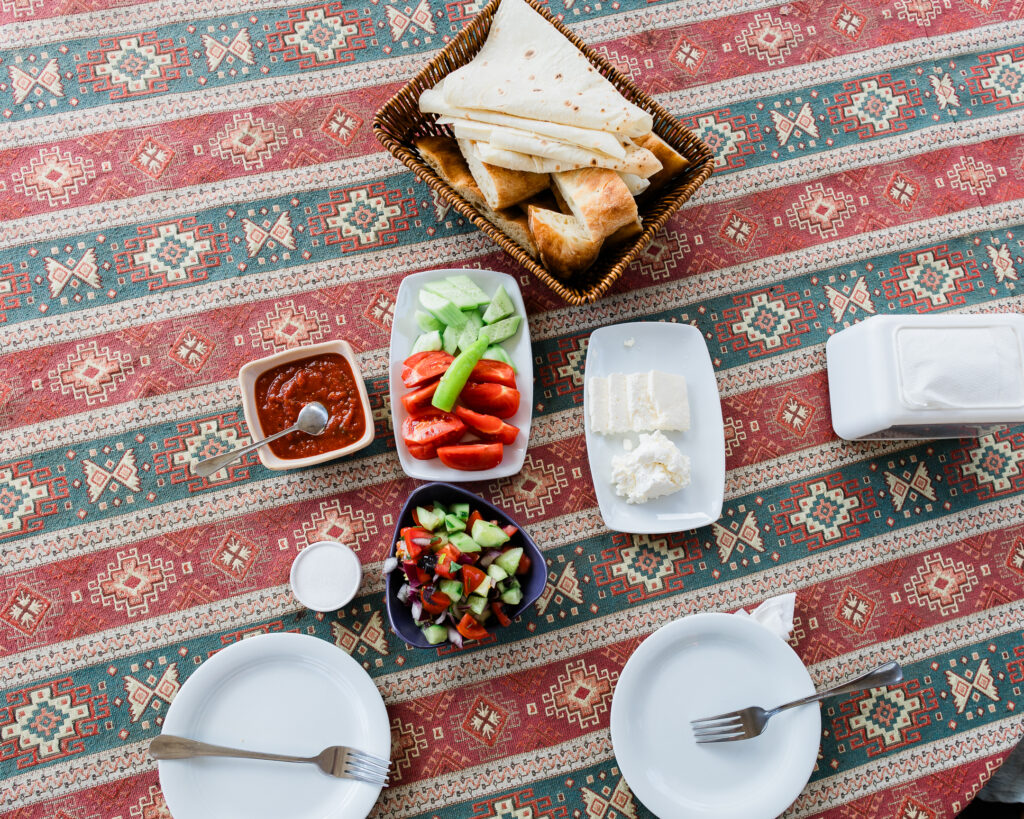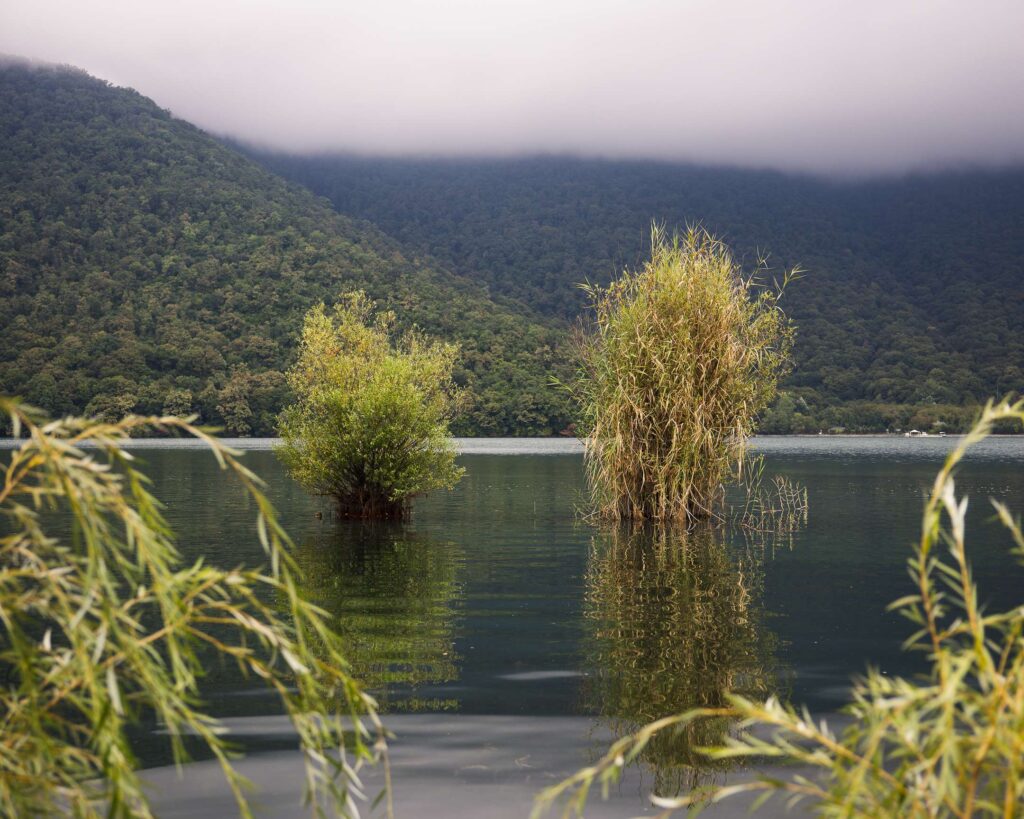Khinaliq: An Unusual Journey to One of the World’s Oldest Villages
Nestled high in the Caucasus Mountains of Azerbaijan lies a village that has stood the test of time: Khinaliq. At an elevation of 2,180 metres (7,150 feet), Khinaliq is not only one of the highest inhabited places in the world but also one of the oldest, with a history that spans over 5,000 years. This ancient village, with its unique culture, language, and breathtaking landscapes, offers a rare glimpse into a way of life that has remained largely unchanged for centuries. Its profound cultural significance is recognised by its inscription as a UNESCO World Heritage site: “The Cultural Landscape of Khinalig People and ‘Köç Yolu’ Transhumance Route,” highlighting its role in preserving a unique semi-nomadic tradition.
The Ancient Heart of Khinaliq
Khinaliq is a place where history and culture are deeply intertwined. The village is home to the Khinalug people, who call themselves the “Kettid” and speak a language unlike any other in the region. Khinalug, often called “Ketsh” by its speakers, is an isolated language with a complex structure and many unique sounds, making it a true linguistic treasure. Thanks to the village’s remote location and the preservation of its traditional semi-nomadic animal husbandry practices, its people have preserved their distinct culture and traditions over millennia. The population, typically a few hundred residents, fluctuates significantly with the seasonal migration of shepherds and their flocks along ancient transhumance routes.
The architecture of Khinaliq also speaks to its ancient roots. The stone houses, built on steep mountain slopes, are stacked atop one another, with the roof of one house serving as the courtyard for the next. This unique architectural style, often using local stone and dried cow dung for construction, keeps the houses remarkably warm and maximises space, fostering a strong sense of communal living that has characterised Khinaliq for generations. Walking through its narrow, unpaved lanes, you often have to climb ladders on the outside of houses to access different levels.
Local Legends and Stories
Khinaliq isn’t just ancient; it’s steeped in mythology. One of the most enduring local legends says that Noah’s Ark came to rest on a nearby mountain, and that the villagers are descendants of Noah himself. Whether you take this as fact or folklore, the setting feels undeniably mythical. The cloud-draped mountains, isolated homes, and untouched terrain make it easy to believe you’ve stepped into a place frozen in time. The village also holds several ancient mosques, like the 12th-century Juma Mosque, and sacred shrines (pirs), some believed to have pre-Islamic, Zoroastrian roots like the Ateshgah (fire temple) on the outskirts.
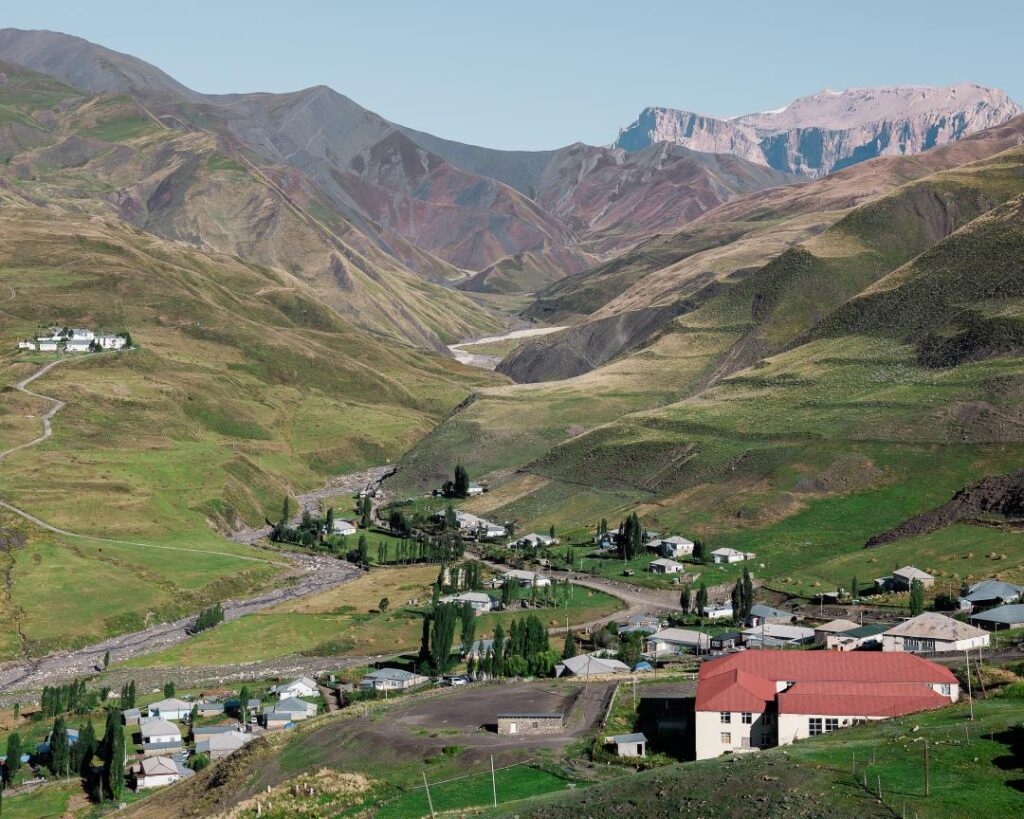
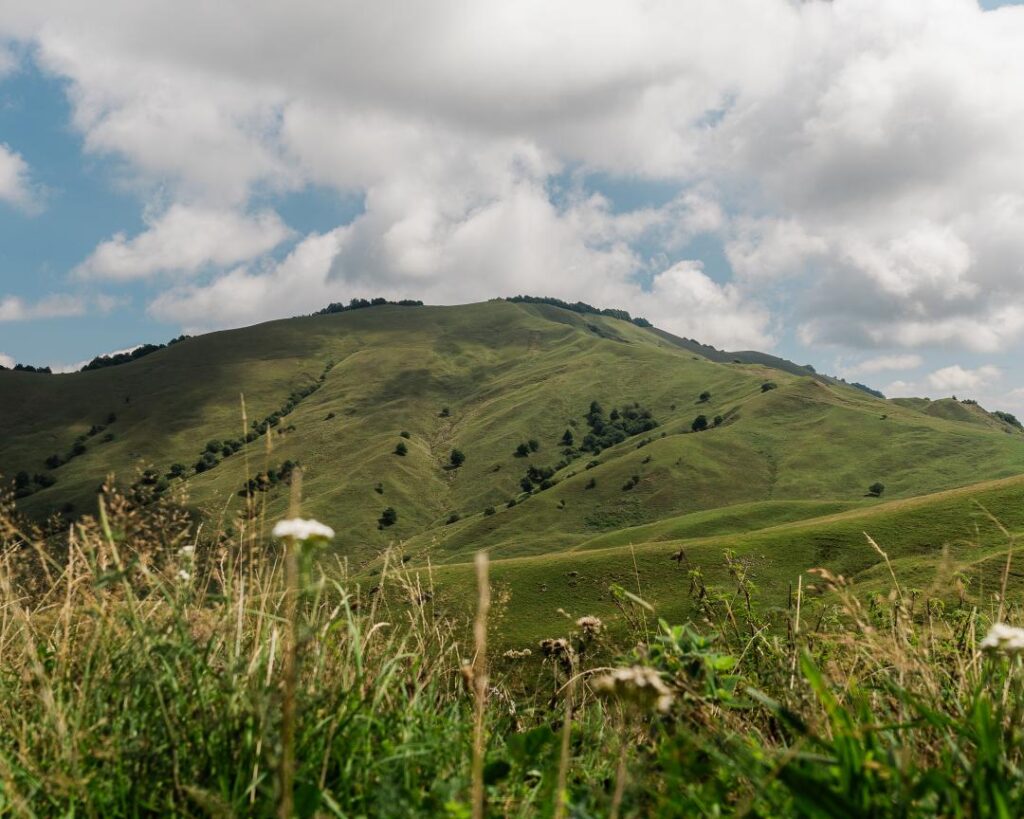
Getting to Khinaliq
Baku to Khinaliq by Car
You have two options: rent a vehicle and drive yourself, or hire a private driver. Renting a vehicle with an experienced driver or as part of a tour is the more popular option and you can check with your hotel. If you’re planning to self-drive (which is what we did) check the road conditions locally before setting out. Things can change quickly in the mountains; landslides and avalanches can occur, leading to road closures. As long as you’re an experienced and confident driver that likes adventures, the journey to Khinaliq should be fine. We recommend using Local Rent to find an affordable rental car in Azerbaijan or there are many local rental shops in Baku we used Emirates Rental that was great.
Baku to Khinaliq by Bus
Quba is a mandatory transit point when travelling between Baku and Khinaliq using public transport. Minibuses to Quba depart frequently (every 20–40 minutes starting from 7:30 am) throughout the day from the International Bus Terminal in Baku. The journey takes around 3 hours and 20 minutes, and tickets cost 5.30 AZN. Be sure to double-check times and prices on Biletim (route: Bakı–Quba).
Khinaliq is located roughly 230 kilometres (143 miles) from Baku via the E119 highway. The first part of the journey follows the Caspian coast before turning inland towards Quba, which is the traditional jumping-off point for Khinaliq. This is your last chance to stock up on snacks, and more importantly, to withdraw cash (there are no ATMs in Khinaliq).
From Quba, it takes another 1.5–2 hours to reach Khinaliq via a mountain road. Though steep and narrow, the road is fully paved (a relatively recent development, completed in 2006. Before that, access was primarily by donkey or on foot, highlighting its deep historical isolation) and generally in good condition. You can also find shared taxis from Quba to Khinaliq, typically costing around 15-20 AZN per person or 50-60 AZN for the whole car.
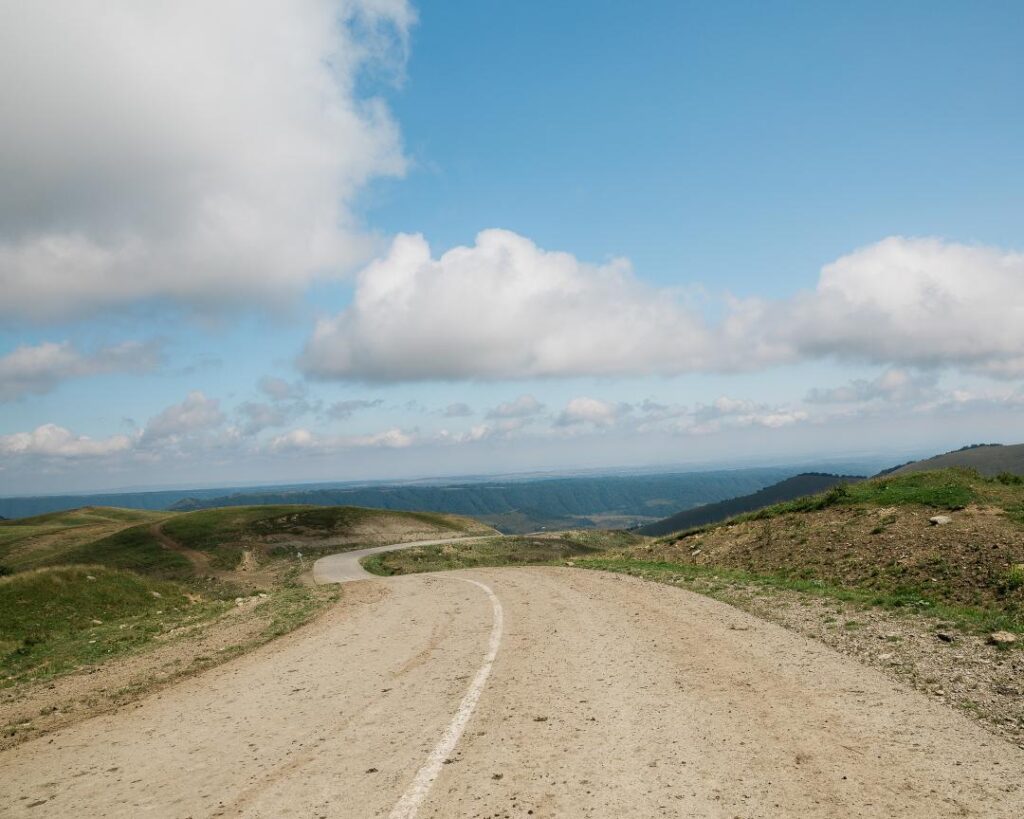

Exploring Khinaliq: What to See and Do
When you visit Khinaliq, you’re not just seeing sights; you’re stepping into a living museum. The village itself, with its unique architecture and surrounding landscapes, is the main attraction. While we had originally planned for a full day in Khinaliq hiking and exploring the beautiful mountains, our car situation meant we had to head back down the next morning. Despite the challenges, this was one of the most memorable travel experiences we’ve ever had. It was 6 degrees outside, but the breathtaking mountain views made the crisp air an invigorating part of the experience. We truly felt like we were standing at the edge of the world.
Here’s what you can “see” and experience in Khinaliq:
- The Ancient Stone Houses & Unique Architecture: Wander through the village’s narrow, unpaved lanes to admire the unique, stacked stone houses built directly into the steep mountainside. Notice how the roof of one house often serves as the courtyard for the next, reflecting centuries of communal living and ingenious space utilisation. This distinct construction style, using local stone and dried cow dung for insulation, which helps keep the houses warm, creates a fascinating labyrinth of homes.
- The Khinaliq Museum: We visited this small but insightful museum, which offers a glimpse into the village’s rich history and the unique culture of the Khinalug people. It’s a great place to see local artefacts, traditional tools, and old photographs.
- The Mosques and Sacred Sites: Explore the ancient mosques, like the 12th-century Juma Mosque, which often offers commanding views over the village and surrounding valleys. Keep an eye out for other sacred shrines (pirs) scattered around the village, some of which are believed to have pre-Islamic, Zoroastrian roots like the Ateshgah (fire temple) on the outskirts.
- Breathtaking Mountain Panoramas: Simply walking around the village, especially towards its outskirts or higher points, provides jaw-dropping, “otherworldly” views of the surrounding Caucasus Mountains. These vistas are a highlight for any visitor.
- Observe Local Life and Traditions: Witness the daily life of the “Kettid” people. You might see shepherds tending to their flocks, women engaged in traditional crafts like knitting their famous woollen socks or weaving distinctive Khinalig carpets, or simply experience the warmth of the villagers’ hospitality. The vibrant culture and their unique “Ketsh” language are sights to behold in themselves.
- Hiking and Outdoor Opportunities: Khinaliq is surrounded by stunning alpine scenery that makes it a dream destination for hikers and nature lovers. Popular hikes include:
- Khinaliq to Laza – A long, rugged trail connecting two remote villages. Recommended only for experienced trekkers due to altitude and isolation. This route is part of the traditional “Köç Yolu” transhumance trail used by the Khinalug people for centuries.
- Short local walks – Even a simple walk from the village outskirts offers jaw-dropping views of the Caucasus and nearby pastures dotted with grazing sheep, which form the backbone of the local economy.
Khinaliq is often described as a tourist spot, but without a guide, it doesn’t feel like one. The houses are ancient and many still lived in. It’s more a step back in time than a polished attraction. And that’s what makes it so special. The journey is what makes the destination more beautiful. And no journey is complete without a good story. This was ours.

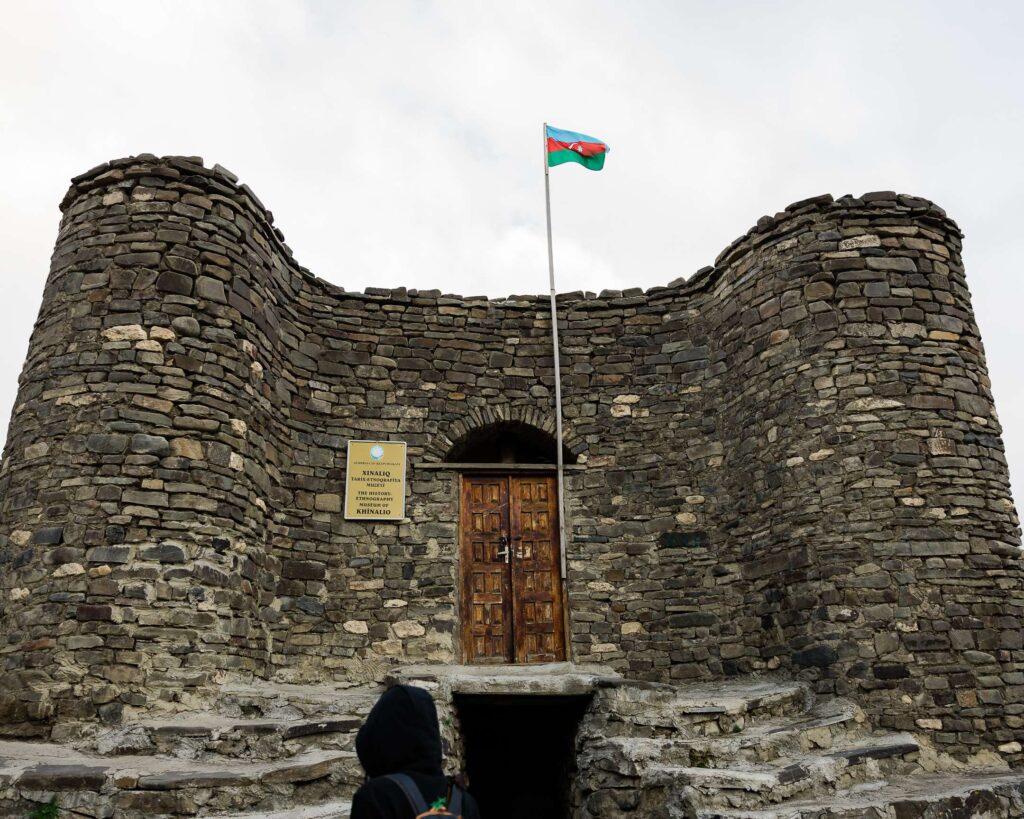


Our Journey to Khinaliq
Our trip began in Baku, where we picked up our rented car. Khinaliq lay approximately 230 kilometres away, with the city of Quba serving as our main departure point. There are two roads leading to Quba: the one closest to the Caspian Sea is smoother and faster, complete with a toll gate (10 AZN at the time of our visit). It’s essential to stop in Quba to eat and pack any dinner supplies, as there are no dining options once you reach Khinaliq unless you’ve pre-arranged meals with your guesthouse.
An Unexpected Detour
The usual route to Khinaliq is the Baku–Khinaliq road. However, on the day we were travelling, we received a message from our guesthouse informing us that a bridge had collapsed. They advised us to take an alternative route through Susay, called the Quba–Susay–Khinaliq road. While the regular road is steep and narrow, this alternative was even more challenging, with steeper inclines and more hairpin turns.
We contacted our car rental provider to check if our Hyundai Elantra could handle the journey. Both the guesthouse and the rental company assured us it was an asphalt road, advising us to drive slowly and confirming that our saloon car would be fine. Cautious but excited, we decided to embark on the journey anyway.
Breathtaking Views and Brake Troubles
The road was incredibly steep but offered one of the most beautiful journeys of our lives. The views were spectacular; mountainscapes that felt almost otherworldly. We had the windows down, breathing in the fresh mountain air. At one point, with just 14km left to the top, we suddenly smelled something from the car and saw smoke coming from the passenger side window. When we pulled over, it was clearly smoke from our brakes. As the road was so steep, the brakes had simply overheated. We were literally in the middle of nowhere, and while we mostly had network, there were stretches where it cut off. We managed to get a signal and speak to the car rental person. He calmly told us it was normal and that we just had to drive slowly and minimise brake use. While we were already doing that on the ascent, on the descent, it would be impossible not to use the brakes. We then decided to let the brakes cool down for a few minutes before slowly continuing our journey.
Khinaliq Hospitality to the Rescue
Slowly but surely, we made it to the top. We called the guesthouse, and someone came to meet us at the small market area, initially asking us to park the car there. However, once the person arrived, we tried to turn the car back on, and it wouldn’t start. A group of old villagers immediately rushed to help. While they couldn’t speak English, they eagerly tried to open the bonnet and assist us in starting the car. Very shortly, Clyde was able to figure out it was a loose battery issue and got the car running again. That was our first glimpse of the incredible warmth and hospitality we would witness from the people of Khinaliq.
We then proceeded to the guesthouse. The owner sent a young man, possibly his son, who led us to the house. The road we drove on from the market/entry point of Khinaliq village to the guesthouse itself was completely crumbling and so narrow that, looking back, we can’t believe the car even went there. We were tired at that point and somehow managed to get the car there.
Once we reached Khinaliq, we took some time to explore the town till it got dark. It was truly beautiful. The village itself felt incredibly ancient, as if time had stood still for centuries. Many houses were built using traditional methods, including walls made partly from a mixture of cow dung and straw, which gives the village its unique, earthy appearance. We then entered the Khinaliq Museum, a small place passionately maintained by the family. The son, who spoke a little English, gave us a short tour alongside his father. The young boy was clearly excited to meet us and enthusiastically showed us around, pointing out all the significant places we should see. While entry is free, donations are welcome to help maintain this historical gem. We explored as much of the area as we could before heading back.
A Warm Welcome and Bollywood Nights
We finally reached the guesthouse and were welcomed by an elderly couple and what seemed like their grandchild. The grandparents in the house spoke no English whatsoever, but the experience more than made up for any language barrier. The place looked nothing like the photo we had seen online, but they immediately served us tea and fruit, making us feel genuinely welcome. Despite the language barrier, we sat with them until 10 pm. Once he saw us, the grandfather recognised that we were Indian and immediately put on 90s Bollywood songs featuring Shah Rukh Khan. He told us how he had watched several Raj Kapoor movies and other classics like ‘Sita and Gita’ growing up. Later that night, he even showed us Bollywood films dubbed in Azerbaijani or Russian on YouTube, explaining that’s how he watched them.
It’s worth noting that the shared toilet facilities with the family were in a condition that was a little beyond usable, making it quite a challenge to get through the night. Therefore, unless you are the adventurous type and comfortable adjusting to very basic settings, you might want to consider a day trip to Khinaliq rather than an overnight stay.
A Memorable Descent and Lasting Impressions
While we had originally planned for a full day in Khinaliq hiking and exploring the beautiful mountains, our car situation meant we had to head back down the next morning. Despite the challenges, this was truly one of the most memorable and unforgettable travel experiences we’ve ever had.
The drive both to and from Khinaliq offered remarkable views at every turn. We stopped a few times on the downhill journey, captivated by the scenery, watching cattle leisurely crossing the road. At times, we literally had our heads in the clouds, enveloped by the mist. It was 6 degrees Celsius outside, but the breathtaking mountain views made the crisp air an invigorating part of the experience. We truly felt like we were standing at the edge of the world.


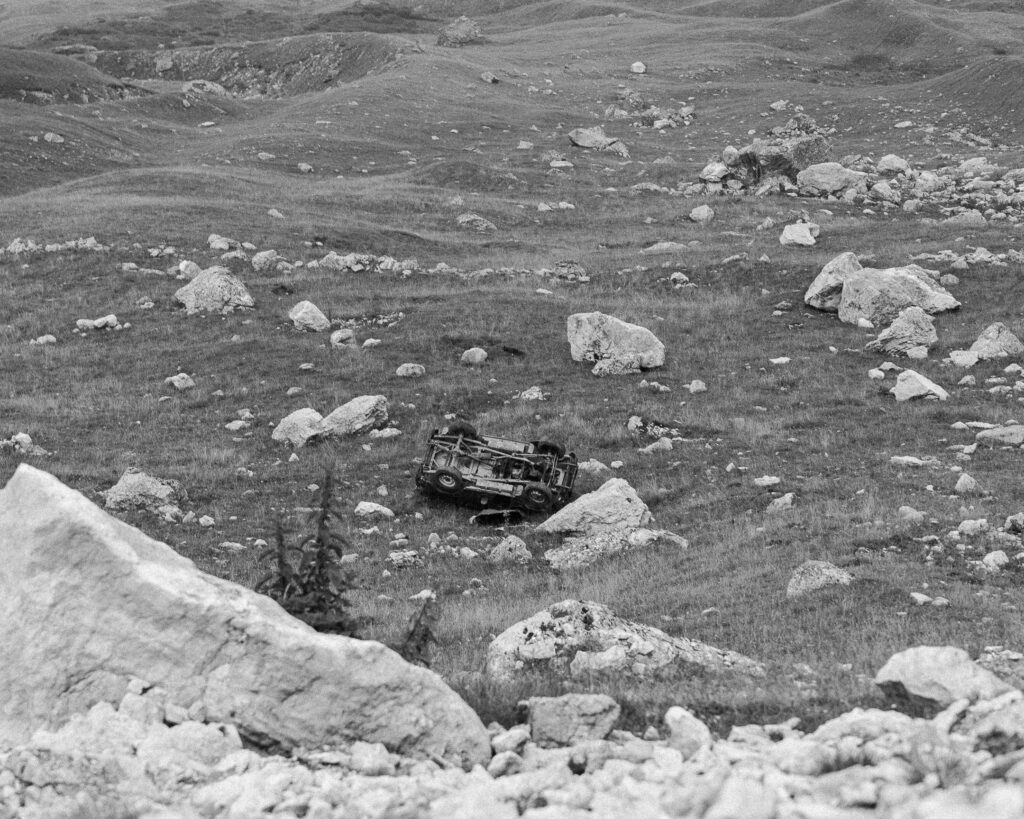
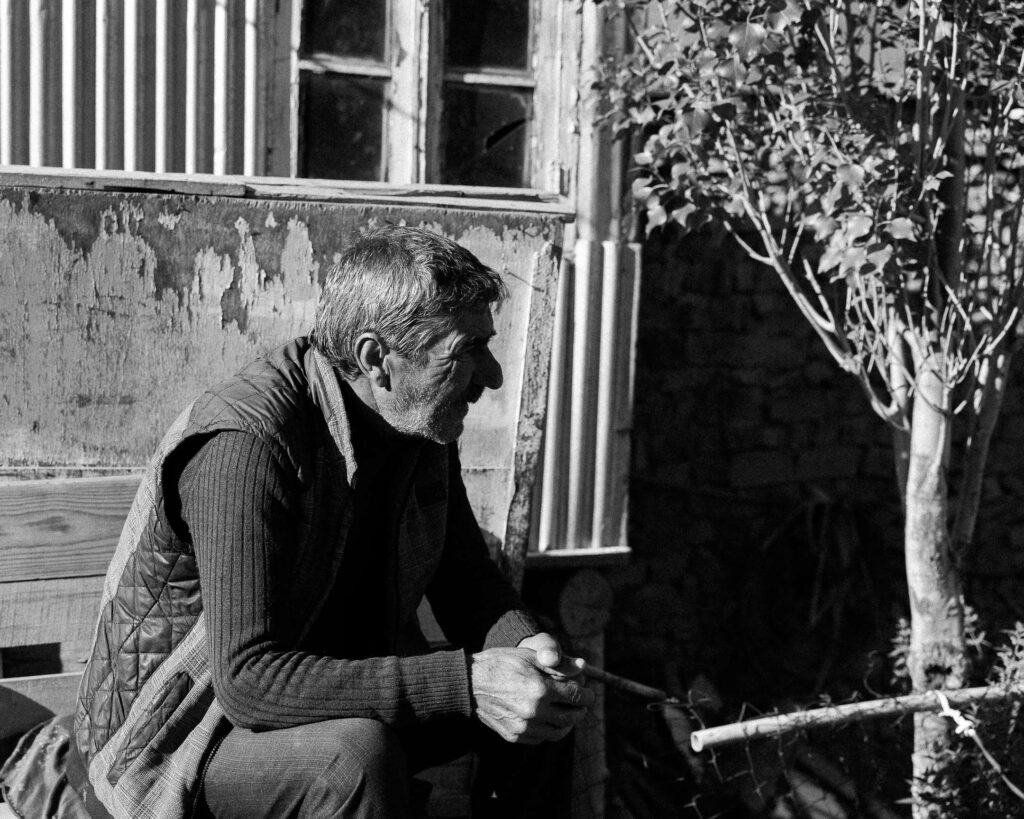
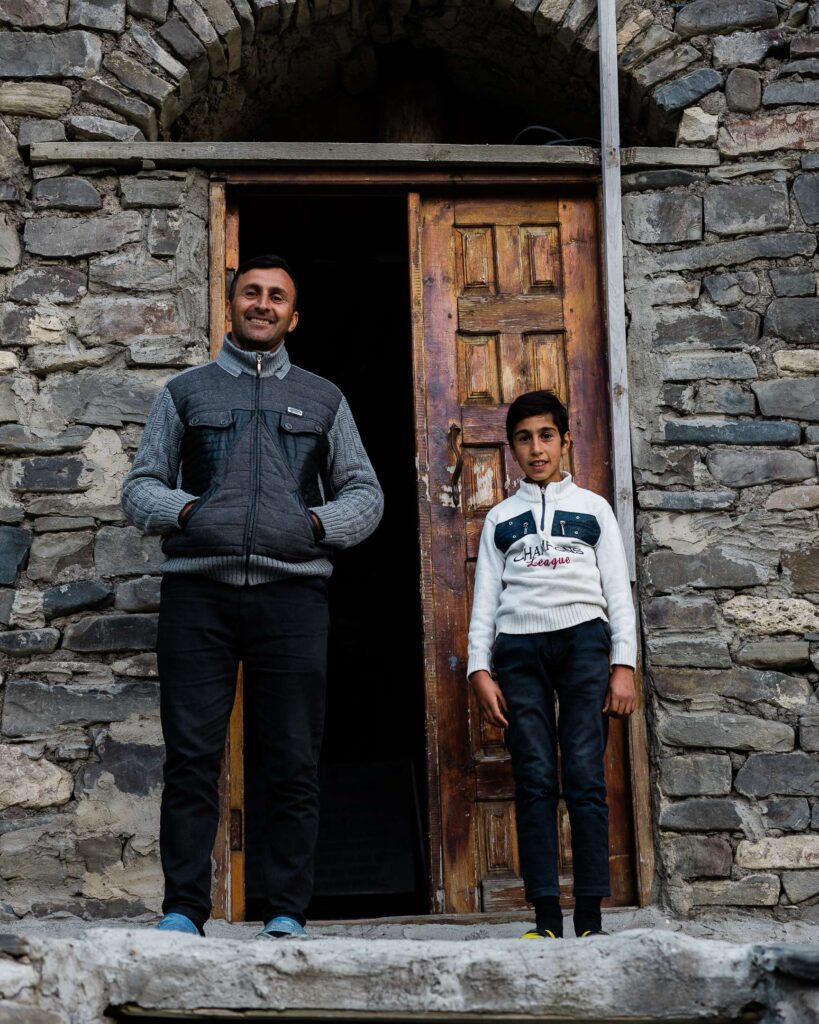
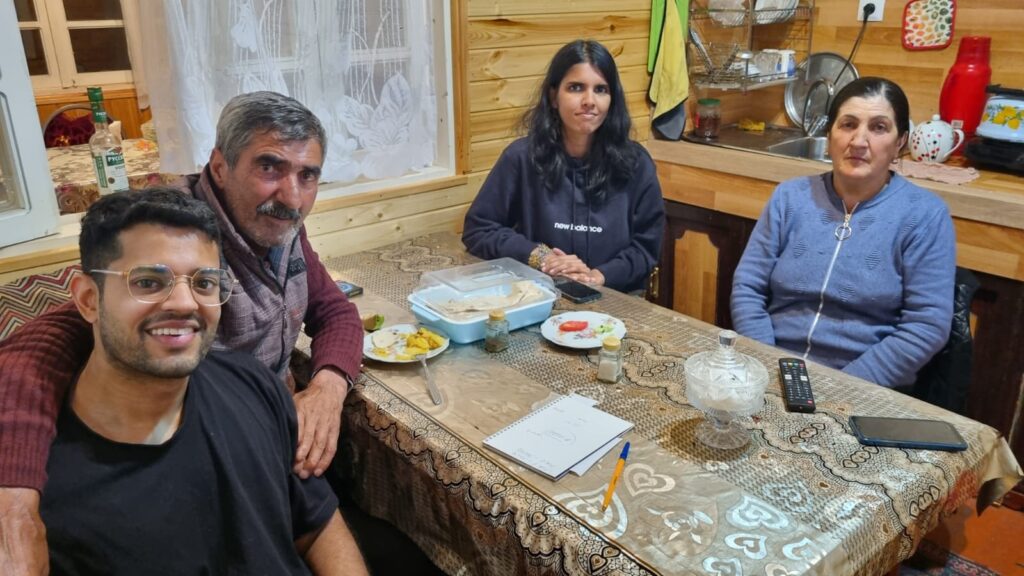
Cultural Practices and Etiquette
Khinaliq is a conservative and deeply traditional community. Here are a few tips to ensure your visit is respectful:
- Dress modestly, especially when walking through the village or visiting the mosque and other sacred sites (pirs).
- Always ask permission before photographing people, particularly elders and women.
- Greetings matter. Locals appreciate a simple wave or a nod. A few words in Azerbaijani (or even Russian, which many older villagers speak) can go a long way.
- Don’t expect English. We met a couple of kids that speak English, as their school now teaches English. But no-one else does. Very few locals speak it, but they are incredibly warm and welcoming if you make an effort to connect. Language is never a barrier.
Practical Tips for Travellers
When to visit:
The best time is from June to September, when the weather is mild and the roads are more accessible. Winter travel can be extremely challenging due to heavy snowfall and road closures.
What to pack:
Warm clothing. Even in summer, temperatures can drop at night. Good walking shoes are essential for navigating steep, uneven paths.
Food and water for the way and even dinner. Quba is the last stop you’ll make where shops and restaurants are available.
Getting there:
Khinaliq is most easily reached via Quba. Hire a driver or drive cautiously. Consider a 4×4, especially if taking the Quba–Susay–Khinaliq route. Remember that the paved road into Khinaliq itself is quite steep and winding.
Where to stay:
There are no hotels in Khinaliq. Only family-run guesthouses. It’s important to note that medical facilities, like hospitals, are not available in the village, so prepare accordingly for any health needs. Also, while the views outside were breathtaking, we learned that the indoor toilets might not be as impressive! It’s part of the authentic, rustic experience.
- Zaur Guest Hause (top-rated)
- Mountain House
- Xinaliq Qonaq Evi
Reflecting on the Experience
Our trip to Khinaliq was more than just a drive to a remote village. It was a journey through time. The village’s isolation and its inhabitants’ dedication to their ancestral way of life, including the transhumance tradition, have helped preserve a culture that has almost vanished from the modern world. It was truly remarkable to witness how modern society seamlessly connected with this ancient village; seeing a house made of cow dung and stone having high speed internet, and how Bollywood films had reached even the most remote corners of the world, truly underscored the power of culture to connect us all.
Khinaliq stands as a testament to human resilience and the timeless beauty of the Caucasus. We left with more than just memories of dramatic landscapes and kind people. We left with a deep respect for this remarkable place and its enduring culture.
Whether you’re a seasoned traveller or seeking a unique adventure, Khinaliq will stay with you long after you’ve left. If you ever find yourself in Azerbaijan, take the road less travelled. And visit Khinaliq. It’s a journey you’ll never forget.
If you are looking for a similar experience but a less challenging journey with equally scenic views check out our article on Kazbegi, Georgia.

